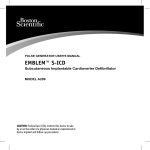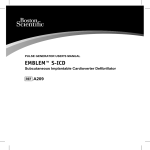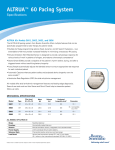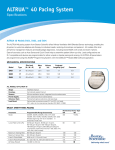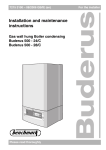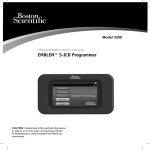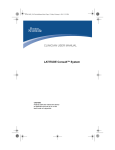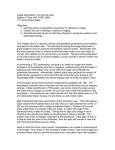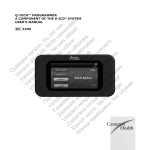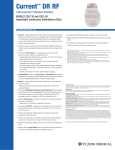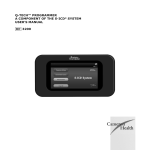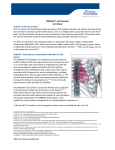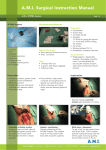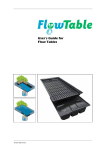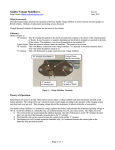Download EMBLEM™ S-ICD - Subcutaneous Electrode
Transcript
USER'S MANUAL EMBLEM™ S-ICD Subcutaneous Electrode Insertion Tool MODEL 4711 CAUTION: Federal law (USA) restricts this device to sale by or on the order of a physician trained or experienced in device implant and follow-up procedures. EMBLEM is a trademark of Boston Scientific. Table of Contents Description1 Related Information 1 Intended Audience 2 Indications for Use 2 Contraindications2 Warnings2 General3 Handling4 Implantation5 Precautions6 Clinical Considerations 6 Sterilization and Storage 6 Implantation7 Potential Adverse Events 8 Using the EMBLEM S-ICD Subcutaneous Electrode Insertion Tool 10 Items Included in Package 10 Implanting the S-ICD System 11 Creating the Device Pocket 13 Implanting the EMBLEM S-ICD Subcutaneous Electrode 14 EMBLEM S-ICD Subcutaneous Electrode Insertion Tool Diagram 21 EMBLEM S-ICD Subcutaneous Electrode Insertion Tool Specifications22 Definitions of Package Label Symbols 22 Warranty Disclaimer 24 Description The EMBLEM™ S-ICD subcutaneous electrode insertion tool (the “EIT”) is a component of the Boston Scientific S-ICD System, which is prescribed for patients when cardiac arrhythmia management is warranted. The EIT is used to create a subcutaneous tunnel to facilitate implantation of the EMBLEM S-ICD subcutaneous electrode. The EMBLEM S-ICD EIT is also compatible with the Cameron Health Model 3010 Q-TRAK subcutaneous electrode. Related Information For additional information about other components of the S-ICD System, refer to the following: • EMBLEM S-ICD Pulse Generator User’s Manual • EMBLEM S-ICD Subcutaneous Electrode User’s Manual • EMBLEM S-ICD Programmer User’s Manual A summary of the S-ICD System Clinical Investigation, including observed adverse events, can be obtained by contacting Boston Scientific using the information on the back cover. 1 Intended Audience This literature is intended for use by professionals trained or experienced in device implant and/or followup procedures. Indications for Use The S-ICD System is intended to provide defibrillation therapy for the treatment of life threatening ventricular tachyarrhythmias in patients who do not have symptomatic bradycardia, incessant ventricular tachycardia, or spontaneous, frequently recurring ventricular tachycardia that is reliably terminated with anti-tachycardia pacing. Contraindications Unipolar pacing and impedance-based features are contraindicated for use with the S-ICD System. Warnings Note: Before using the S-ICD System, read and follow all warnings and precautions provided in the EMBLEM S-ICD Pulse Generator User’s Manual. 2 General • • Labeling knowledge. Read this manual thoroughly before using the S-ICD System to avoid damage to the pulse generator and/or subcutaneous electrode. Such damage can result in patient injury or death. For single patient use only. Do not reuse, reprocess, or resterilize. Reuse, reprocessing, or resterilization may compromise the structural integrity of the device and/or lead to device failure which, in turn, may result in patient injury, illness, or death. Reuse, reprocessing, or resterilization may also create a risk of contamination of the device and/or cause patient infection or cross-infection, including, but not limited to, the transmission of infectious disease(s) from one patient to another. Contamination of the device may lead to injury, illness, or death of the patient. 3 • • Component Compatibility. All Boston Scientific S-ICD implantable components are designed for use with the Boston Scientific or Cameron Health S-ICD System only. Connection of any S-ICD System components to a non-compatible component will result in failure to deliver life-saving defibrillation therapy. Backup defibrillation protection. Always have external defibrillation equipment and medical personnel skilled in CPR available during implant and follow-up testing. If not terminated in a timely fashion, an induced ventricular tachyarrhythmia can result in the patient’s death. Handling • • 4 Proper Handling. Handle the components of the S-ICD System with care at all times and maintain proper sterile technique. Failure to do so may lead to injury, illness, or death of the patient. Do not damage components. Do not modify, cut, kink, crush, stretch or otherwise • damage any component of the S-ICD System. Impairment to the S-ICD System may result in an inappropriate shock or failure to deliver therapy to the patient. Handling the subcutaneous electrode. Use caution handling the subcutaneous electrode connector. Do not directly contact the connector with any surgical instruments such as forceps, hemostats, or clamps. This could damage the connector. A damaged connector may result in compromised sealing integrity, possibly leading to compromised sensing, loss of therapy, or inappropriate therapy. Implantation • System dislodgement. Use appropriate anchoring techniques as described in the implant procedure to prevent S-ICD System dislodgement and/or migration. Dislodgement and/or migration of the S-ICD System may result in an inappropriate shock or failure to deliver therapy to the patient. 5 Precautions Clinical Considerations • • Pediatric Use. The S-ICD System has not been evaluated for pediatric use. Available Therapies. The S-ICD System does not provide long-term bradycardia pacing, cardiac resynchronization therapy (CRT) or anti-tachycardia pacing (ATP). Sterilization and Storage • • 6 If package is damaged. The electrode insertion tool is sterilized with gamma irradiation and is packaged in a sterile container. When the electrode insertion tool is received, it is sterile provided the container is intact. If the packaging is wet, punctured, opened, or otherwise damaged, return the electrode insertion tool to Boston Scientific. Use by date. Use the electrode insertion tool before or on the USE BY date on the package label because this date reflects a validated • shelf life. For example, if the date is January 1, do not use on or after January 2. Storage Temperature. The recommended storage temperature range is -18°C to +55°C (0°F to +131°F). Implantation • • • Creating the subcutaneous tunnel. Use only the electrode insertion tool to create the subcutaneous tunnel when implanting and positioning the subcutaneous electrode. Avoid tunneling close to any other subcutaneously implanted medical devices or components, for example an implantable insulin pump, drug pump, or ventricular assist device. Suture location. Suture only those areas indicated in the implant instructions. Do not suture directly over subcutaneous electrode body. Do not suture directly over the subcutaneous electrode body, as this may cause structural damage. Use the suture sleeve to prevent subcutaneous electrode movement. 7 • Sternal wires. When implanting the S-ICD system in a patient with sternal wires, ensure that there is no contact between the sternal wires and the distal and proximal sense electrodes (for example, by using fluoroscopy). Compromised sensing can occur if metal-to-metal contact occurs between a sense electrode and a sternal wire. If necessary, re-tunnel the electrode to ensure sufficient separation between the sense electrodes and the sternal wires. Potential Adverse Events Potential adverse events related to implantation of the S-ICD System may include, but are not limited to, the following: • Acceleration/induction of atrial or ventricular arrhythmia • Adverse reaction to induction testing • Allergic/adverse reaction to system or medication • Bleeding • Conductor fracture • Cyst formation • Death 8 • • • • • • • • • • • • • • • • • • • • • • • • • Delayed therapy delivery Discomfort or prolonged healing of incision Electrode deformation and/or breakage Electrode insulation failure Erosion/extrusion Failure to deliver therapy Fever Hematoma/seroma Hemothorax Improper electrode connection to the device Inability to communicate with the device Inability to defibrillate or pace Inappropriate post-shock pacing Inappropriate shock delivery Infection Keloid formation Migration or dislodgement Muscle/nerve stimulation Nerve damage Pneumothorax Post-shock/post-pace discomfort Premature battery depletion Random component failures Stroke Subcutaneous emphysema 9 • • • Surgical revision or replacement of the system Syncope Tissue redness, irritation, numbness or necrosis If any adverse events occur, invasive corrective action and/ or S-ICD System modification or removal may be required. Patients who receive an S-ICD System may develop psychological disorders that include, but are not limited to, the following: • Depression/anxiety • Fear of device malfunction • Fear of shocks • Phantom shocks Using the EMBLEM S-ICD Subcutaneous Electrode Insertion Tool Items Included in Package The EMBLEM S-ICD subcutaneous electrode insertion tool has been sterilized with gamma irradiation and is packaged in a sterile container that 10 is suitable for use in the operating field. Store in a clean, dry area. Each package contains the following: • One EMBLEM S-ICD subcutaneous electrode insertion tool, Model 4711 • One EMBLEM S-ICD Subcutaneous Electrode Insertion Tool User’s Manual Implanting the S-ICD System This section presents the information necessary for implanting the EMBLEM S-ICD subcutaneous electrode using the EMBLEM S-ICD subcutaneous electrode insertion tool (the “EIT”). Warning: All Boston Scientific S-ICD implantable components are designed for use with the Boston Scientific or Cameron Health S-ICD System only. Connection of any S-ICD System components to a non-compatible component will result in failure to deliver life-saving defibrillation therapy. The S-ICD System is designed to be positioned using anatomical landmarks. However, it is recommended to review a pre-implant chest x-ray in order to 11 confirm that a patient does not have notably atypical anatomy (e.g., dextrocardia). Additionally, it is not recommended to deviate from the implant instructions to accommodate for physical body size or habitus, unless a pre-implant chest x-ray has been reviewed. The device and subcutaneous electrode are typically implanted subcutaneously in the left thoracic region (Figure 1). The EIT is used to create the subcutaneous tunnels in which the electrode is inserted. Figure 1: Placement of the S-ICD System 12 Creating the Device Pocket The device is implanted in the left lateral thoracic region. To create the device pocket, make an incision such that the device can be placed in the vicinity of the left 5th and 6th intercostal spaces and near the mid-axillary line (Figure 2). This can be accomplished by making an incision along the inframammary crease. Figure 2: Creating the device pocket 13 Implanting the EMBLEM S-ICD Subcutaneous Electrode The procedure described below is one of several surgical approaches that can be used to appropriately implant and position the electrode. Regardless of the surgical approach, the defibrillation coil must be positioned parallel to the sternum, in close proximity to, or in contact with the deep fascia, approximately 2 cm from the sternal midline (Figure 1). In addition, good tissue contact with the electrode and pulse generator is important to optimize sensing and therapy delivery. Use standard surgical techniques to obtain good tissue contact. For example, keep the tissue moist and flushed with sterile saline, express any residual air out through the incisions prior to closing and, when closing the skin, take care not to introduce air into the subcutaneous tissue. 1. Make a small, 2 cm horizontal incision at the xiphoid process (xiphoid incision). Note: If desired, in order to facilitate attachment of the suture sleeve to the fascia following electrode placement, two suture ties to the fascia 14 can be made at the xiphoid incision prior to continuing. 2. Insert the distal tip of the EIT at the xiphoid incision and tunnel laterally until the distal tip emerges at the device pocket. Note: The EIT is malleable and can be curved to match the patient’s anatomical profile. Caution: Use only the electrode insertion tool to create the subcutaneous tunnel when implanting and positioning the subcutaneous electrode. Avoid tunneling close to any other subcutaneously implanted medical devices or components, for example an implantable insulin pump, drug pump, or ventricular assist device. 3. Using conventional suture material, tie the anchoring hole of the subcutaneous electrode to the EIT creating a long 15-16 cm loop (Figure 3). 15 Figure 3: Connecting the distal end of the subcutaneous electrode to the EIT 4. With the subcutaneous electrode attached, carefully pull the EIT back through the tunnel to the xiphoid incision until the proximal sensing electrode emerges. 5. Place a suture sleeve over the subcutaneous electrode shaft 1 cm below the proximal sensing electrode. Using the preformed grooves, bind the suture sleeve to the subcutaneous electrode shaft using 2-0 silk or similar non-absorbable suture material, making sure not to cover the proximal sensing electrode. Check the suture sleeve after anchoring to assure stability by 16 grasping the suture sleeve with fingers and trying to move the subcutaneous electrode in either direction. Note: Do not secure the suture sleeve and subcutaneous electrode to the fascia until electrode placement is complete. 6. Make a second incision approximately 14 cm superior to the xiphoid incision (superior incision). If desired, place the exposed subcutaneous electrode on the skin to make this measurement. The distance between the superior and xiphoid incisions must accommodate the portion of the subcutaneous electrode from the distal sensing electrode to the proximal sensing electrode. Pre-place one or two fascial sutures in superior incision. Use a non-absorbable suture material of appropriate size for long term retention. Apply gentle traction to ensure adequate tissue fixation. Retain the needle on the suture for later use in passing through the electrode anchoring hole. 7. Insert the distal tip of the EIT into the xiphoid incision and tunnel subcutaneously towards the superior incision, staying as close to the deep fascia as possible (Figure 4). 17 Figure 4: Tunneling to superior incision 8. Once the distal tip of the EIT emerges from the superior incision, disconnect and retain the suture loop from the distal tip of the EIT. Secure the ends of the suture with a surgical clamp. Remove the EIT. 9. Using the secured suture at the superior incision, carefully pull the suture and subcutaneous electrode through the tunnel until the anchoring hole emerges. The subcutaneous electrode should be parallel to the sternal midline with the defibrillation coil in close proximity to the deep fascia. 18 10. Cut and discard the suture material. 11. At the xiphoid incision, secure the suture sleeve with the subcutaneous electrode to the fascia using 2-0 silk or similar non-absorbable suture material. Warning: Use appropriate anchoring techniques as described in the implant procedure to prevent S-ICD System dislodgement and/or migration. Dislodgement and/or migration of the S-ICD System may result in an inappropriate shock or failure to deliver therapy to the patient. Caution: Do not suture directly over the subcutaneous electrode body, as this may cause structural damage. Use the suture sleeve to prevent subcutaneous electrode movement. Caution: Suture only those areas indicated in the implant instructions. Note: Ensure that the suture is securely fastened to fascia by gently tugging on the suture prior to tying to the suture sleeve and subcutaneous electrode. 12. At the superior incision, secure the anchoring hole to the fascia using the pre-placed sutures from step 6 (Figure 5). 19 Figure 5: Anchoring the distal electrode tip of the subcutaneous electrode Note: Ensure that the suture is securely fastened to fascia by gently tugging on the suture prior to tying to the subcutaneous electrode anchoring hole. 13. Gently tug the subcutaneous electrode at the superior incision to ensure the anchoring hole is secured to the fascia. 14. To dispose of the EIT, return the used product to the original package, then dispose in a biohazard container. 15. To ensure good tissue contact with the implanted subcutaneous electrode, flush the xiphoid and superior incisions with sterile saline solution and apply firm pressure along the electrode to express any residual air out through the incisions prior to closing. 20 For information on connecting the subcutaneous electrode to the pulse generator, as well as information about setup of the pulse generator and defibrillation testing, refer to the appropriate S-ICD pulse generator user’s manual. Information on post implant follow-up and explant of the system can also be found in the S-ICD pulse generator and/or subcutaneous electrode manuals. EMBLEM S-ICD Subcutaneous Electrode Insertion Tool Diagram Figure 6: Model 4711 dimensions 21 EMBLEM S-ICD Subcutaneous Electrode Insertion Tool Specifications Table 1: Specifications Component Specification Electrode insertion tool materials Acrylonitrile-butadienestyrene (ABS), stainless steel Transportation, Handling and Storage Temperature Range -18°C to +55°C (0°F to +131°F) Definitions of Package Label Symbols The following table defines the symbols that appear on the product packaging. Table 2: Packaging symbols Symbol Description Sterilized by gamma irradiation 22 Symbol Description Date of manufacture Symbol Description Symbol Description Authorized Representative in the European Community Use by Lot number Temperature limitation Do not reuse Consult instructions for use Reference number Open here Manufacturer Do not resterilize Do not use if package is damaged 23 Warranty Disclaimer Except as otherwise provided herein, Boston Scientific disclaims all express and implied warranties for this product, including without limitation any implied warranties of merchantability or fitness for a particular purpose. Boston Scientific’s obligations under any warranty provided herein shall be limited strictly to replacement of the product. Buyer assumes all risk of loss or damages arising from use of this product. 24 © 2015 Boston Scientific Corporation or its affiliates. All rights reserved. Boston Scientific 4100 Hamline Avenue North St. Paul, MN 55112-5798 USA www.bostonscientific.com 1.800.CARDIAC (227.3422) +1.651.582.4000 359301-001 EN US 2015-02 *359301-001*

































